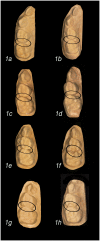OXIS Contacts and Approximal Caries in Preschool Children: A Prospective Cohort Study
- PMID: 36689939
- PMCID: PMC7614808
- DOI: 10.1159/000529160
OXIS Contacts and Approximal Caries in Preschool Children: A Prospective Cohort Study
Abstract
The present prospective cohort study was conducted to evaluate the susceptibility of OXIS contact areas, namely, O (open type), X (point type), I (straight type), and S (curved type) in the development of approximal caries. We conducted this study among 953 school children with 3,812 contacts in Puducherry, India. At baseline, the contacts were assessed in accordance with OXIS criteria. At the end of 12 months, two calibrated dentists measured dental caries following the International Caries Detection and Assessment (ICDAS) criteria. Information about feeding practices, diet, and oral hygiene was collected by means of a structured questionnaire from each child's parent. Data were analyzed by unadjusted and adjusted Poisson regression analysis with a multilevel approach. The two levels of analysis were tooth and child. Of 3,812 contacts observed during the follow-up, 127 (3.3%) were observed as carious. Poisson regression analysis revealed a significant association between type of contact and caries prevalence (p < 0.05). The risk ratios for the development of approximal caries in X contacts were 2.4 (0.3-17.2), p value 0.38; in I contacts 4.9 (1.2-19.9), p value 0.027; and in S contacts 8.2 (1.9-34.2), p value 0.004, when compared with the O contacts. Among the child variables, male gender (relative risk [RR] = 2.1; 95% confidence interval [CI], 1.3, 3.5), parental supervision while toothbrushing (RR = 1.6; 95% CI, 1.1, 2.4), and the use of toothpaste (RR = 1.9; 95% CI, 1.3, 3.1) were found to be associated with approximal caries after adjustment for the other variables. Among the OXIS contacts, the S type was most susceptible to approximal caries due to its complex morphology, followed by I, X, and O.
Keywords: Approximal caries; OXIS contact areas; Preschool children; Primary molars.
© 2023 S. Karger AG, Basel.
Conflict of interest statement
The authors have no conflicts of interest to declare.
Figures
Similar articles
-
Variations in Primary Molar Contact and Approximal Caries in Children: A Three-Year Prospective Cohort Study.Pediatr Dent. 2023 Sep 15;45(5):434-442. Pediatr Dent. 2023. PMID: 37904267 Free PMC article.
-
OXIS Contacts as a Risk Factor for Approximal Caries: A Retrospective Cohort Study.Pediatr Dent. 2021 Jul 15;43(4):296-300. Pediatr Dent. 2021. PMID: 34467847 Free PMC article.
-
OXIS Classification of Interproximal Contacts of Primary Molars and Its Prevalence in Three- to Four-Year-Olds.Pediatr Dent. 2020 May 15;42(3):197-202. Pediatr Dent. 2020. PMID: 32522322
-
More than clean teeth! Identifying factors that contribute to the development of early childhood caries.Evid Based Dent. 2024 Jun;25(2):87-88. doi: 10.1038/s41432-024-01009-3. Epub 2024 May 13. Evid Based Dent. 2024. PMID: 38740974
-
Oral hygiene and dental caries--a review.Int Dent J. 1978 Mar;28(1):1-6. Int Dent J. 1978. PMID: 346493 Review.
Cited by
-
Variations in Primary Molar Contact and Approximal Caries in Children: A Three-Year Prospective Cohort Study.Pediatr Dent. 2023 Sep 15;45(5):434-442. Pediatr Dent. 2023. PMID: 37904267 Free PMC article.
-
Development of 'OXIS Classification' calibration website for dental researchers.Eur Arch Paediatr Dent. 2024 Aug;25(4):501-511. doi: 10.1007/s40368-024-00908-4. Epub 2024 May 19. Eur Arch Paediatr Dent. 2024. PMID: 38762826
-
Cytotoxicity of Bulk-Fill Composites on Stem Cells from Human Exfoliated Deciduous Teeth-An In Vitro Study.Materials (Basel). 2025 Aug 18;18(16):3863. doi: 10.3390/ma18163863. Materials (Basel). 2025. PMID: 40870180 Free PMC article.
-
Prevalence of different types of interproximal contacts in the permanent dentition - a study cast evaluation.Wellcome Open Res. 2024 Aug 19;8:176. doi: 10.12688/wellcomeopenres.18973.3. eCollection 2023. Wellcome Open Res. 2024. PMID: 38989242 Free PMC article.
-
Classification of the Type of Contact Between Primary Molars as an Indicator of the Likelihood of Future Caries.Children (Basel). 2025 Jan 29;12(2):161. doi: 10.3390/children12020161. Children (Basel). 2025. PMID: 40003263 Free PMC article.
References
-
- Allison PJ, Schwartz S. Interproximal contact points and proximal caries in posterior primary teeth. Pediatr Dent. 2003;25(5):334–40. - PubMed
-
- Cortes A, Martignon S, Qvist V, Ekstrand KR. Approximal morphology as predictor of approximal caries in primary molar teeth. Clin Oral Invest. 2018;22(2):951–9. - PubMed
Publication types
MeSH terms
Substances
Grants and funding
LinkOut - more resources
Full Text Sources
Medical


